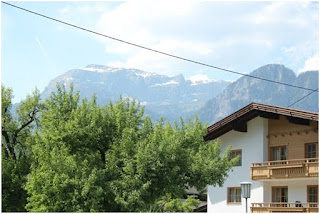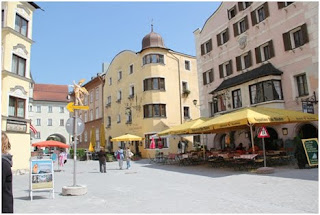Day 3, 5th of May, 2011
The heater in the apartment is not working today. They (I don’t know who runs this place) turned it off. I was freezing my ass of last night and staying indoors is also not really an option now.
The place I am staying at is called Pension Sonhoff. Well kept and has all the basic amenities except one thing...service. If we need something, we have no idea where the reception is or if they even have one. Have no idea who to call or how to get in touch with anyone if I run out of toilet paper. Other than the excellent ‘no service’ it is a comfortable place.
Luckily, I made plans to visit Innsbruck today. It’ll take my mind off the cold.
I took the train from Radfeld to Innsbruck. I paid EUR 16.60 for a return ticket. The ride there took me approximately 40minutes and I truly enjoyed the landscape.
English is not widely spoken here so I had to listen closely to the destination announcements. I walked towards the ‘Altstadt’ (Old Town) immediately. The Old City with its famous Golden Roof is the heart of Innsbruck, and is the centre of attraction.
I was captivated by the amazing medieval architectures and the history behind it all.
The Imperial Palace, Ambras Palace, Ottoburg and the Wilten Basilica all tell of Innsbruck’s eventful past and its great figures including Philippine Welser, the secret wife of Archduke Ferdinand I, Andreas Hofer, the Tirolean freedom fighter, and last but not least Emperor Maximilian I, who built many of the monuments that survive today, e.g. the Golden Roof and his tomb at the Imperial Church. Of course, I learned all this in my short day-trip.
This is what I found on Wikipedia:
Innsbruck is the capital city of the federal state of Tyrol in western Austria. It is located in the Inn Valley at the junction with the Wipptal (Sill River), which provides access to the Brenner Pass, some 30 km (18.64 mi) south of Innsbruck. Located in the broad valley between high mountains, the Nordkette (Hafelekar, 2,334 metres (7,657 ft) in the north, Patscherkofel (2,246 metres (7,369 ft)) and Serles (2,718 metres (8,917 ft)) in the south, it is an internationally renowned winter sports centre, and hosted the 1964 and 1976 Winter Olympics and the 1984 and 1988 Winter Paralympics. It is to host the 1st Winter Youth Olympics in 2012. The word bruck comes from the German word Brücke meaning "bridge" which leads to "the bridge over the Inn".
Due to its location between high mountains, Innsbruck serves as an ideal place for skiing in winter, and mountaineering in summer. The Olympic Winter Games were held in Innsbruck twice, first in 1964, then again in 1976. Tourism is the most important source of income for the city authority, largely because of Innsbruck's beautiful town centre with its historic buildings, the friendly ambience and the extensive sport facilities both in winter and in summer.

The Golden Roof was built by Archduke Friedrich IV in the early 15th century as the residence of the Tirolean sovereigns. The Golden Roof actually is the three-story balcony on the central plaza at the heart of the Old Town. It was constructed for Emperor Maximilian I to serve as a royal box where he could sit in state and enjoy tournaments in the square below. Completed at the dawn of the 16th century, the Golden Roof was built in honor of Maximilian's second marriage, to Bianca Maria Sforza of Milan. Not wishing to alienate the allies gained by his first marriage, to Maria of Burgundy, he had an image of himself between the two women painted on his balcony. (Courtesy of wikipedia)

Maria-Theresien-Strasse.
Named after the wife of Roman German Emperor Franz Stephen, is the most magnificent strret in Innsbruck.

Extremely popular amongst tourists and locals alike. In Innsbruck the architecture defines the place.
Infirmary Church
The doors in the two porches have very detailed carvings and the interios is strikingly decorated with opukent stucco. Was officially mentioned in records as early as 1326.


The frescos were repainted after being damaged by bombs during the 2nd World War. A gothic crucifix is integrated in the high altar, built in 1705.
St. James Cathedral on Domplatz

‘Domkirche St Jakob’ was built between 1717 and 1724 on the site of an earlier Gothic church. Based on designs by the architect Johann Jakob Herkommer it has an extravagant Baroque interior, much of which was completed by the Asam brothers of Munich.

It houses some notable works of art including the ‘Madonna and Child’ by the German master Lucas Cranach the Elder, situated above the high altar. (Courtesy of an Austria attraction.com)

There is also a monument to Archduke Maximilian III constructed in 1620, two years after his death.
One of the highlights is the famous ‘Mariahilf’ (Our Lady of Succour) that has hung there since 1650. It is probably the most famous Madonna in the world and has made the church one of the most important places of pilgrimage to the Virgin Mary.
The Maximilian Archduke’s tomb has one of the most magnificent bronze works of art from the final years of the Renaissance.

St. Anna’s Column
On Maria-Theresien Strasse
The memorial column was erected in thanksgiving for the turning back of the Bavarian invasion during the Spanish War of Succession on St. Anna’s Day (26th July 1703)

A statue of the Virgin Mar on a crescent moon tops the red marble Corinthian column.
In memory of an oath sworn in 1704, the lantern attached to the column beneath St. Anna is lit every Saturday evening.
Helbinghaus
On Herzog-Friedrich-Strasse
This 15th century town house with its oriels at the front and on the corners was originally late Gothic in style.

The splendid high Baroque stucco facade of this superb bourgeois house dates from 1730.

The house named after Sebastian Holbling, who ran a cafe there in 1833 that was famous throughout the city.
Golden Eagle
On Herzog-Friedrich-Strasse 6

The original Goldener Adler was built in 1390 and reconstructed after a fire in 1450.
The late Gothic frescos on the facade were rediscovered in the 1957/1964. Today the 4-star hotel counts as one of the oldest and grandest hotels in Europe.

Its more famous guests have included Amadeus Mozart, Emperor Maximilian and many others.
Ottoburg
On Herzog-Friedrich-Strasse 1

A monument for the Tirolean freedom fighters of 1809 in front of the house.
The late Gothic residential tower was built by order of Emperor Maximilian 1 around 1476. From 1515 onwards the Ottoburg was owned by private citizens rather than noblemen. This is probably the reason why the house was referred to as ‘Eepurg’ from 1565-1568 – ‘oed Burg’ (empty castle) because nobody was living inside it and from 1628, it was called ‘Ottoburg’.

Ottoburg was built as a fortified house in 1476. Oldest building in the Herzog-Friedrich-Straße. It is built in the 15th century at the city wall. Today there is a restaurant in one part.

The Imperial Palace or Hofburg was completed at the end of the 14th century. After that the building was reconstructed and extended several times. The main reconstruction was ordered by Maria Theresia in 18th century. In this time the palace acquired its nowadays Barouque and Rococo motifs. The building is flanked by graceful domed towers. Most of the rooms and halls are decorated with pictures depicting the portraits of Hansburg family members. It has two wings starting from the "Giant’s Hall" or the "Riesensaal", which has a central position in the palace. This is a 31m long hall on two storeys, lavishly decorated with gold and porcelain, featuring gorgeous ceilings with frescoes and walls adorned with portraits of Maria Theresia and her family. All of her 16 children, depicted on the walls, have almost identical faces. It is possible that the artist made them similar in order to avoid any royal wrath aroused by the beauty rivalry between the empress’ children. The structure also has a Gothic Cellar which is offered for special occasions. There are guided tours included in the admission ticket rate, but unfortunately they are held in German only. However, visitors can buy a booklet in English at the entrance. The Hofburg entrance ticket costs € 7.00 for adults, euro; 5.00 for seniors and euro; 1.10 for students. (Courtesy of Innsbruck hotels)

I missed the chance to get in. Sigh.
I didn’t get to see all the things I wanted to, of course that make sense since it was only a day trip.
The next time I visit Innsbruck, I’d sure to catch these things:
- The Dominique Perrault’s Rathausgalerie and Zaha Hadid’s Bergisel Ski Jump and Hungerburgbahn outstanding new landmarks have recently been added to Innsbruck’s modern cityscape.
- Imagine boarding the Hungerburgbahn and 20 minutes later you are on top of the Nordkette looking down at the city of Innsbruck.
- A gondola ride up Seegrube (2000m) from where you enjoy spectacular views of the Inn valley and the surrounding mountains.
- A visit to Swarovski Crystal Worlds in Wattens. Designed by Andre Heller this underground fairy tale world lures you into a very different and sparkling world.
- The famous Innsbruck Dance Summer during Innsbruck Festival Week – around 14th June – 15th July.
- Visit the Maximilianeum and the Imperial Castle from the inside.
- Go into some of the historical buildings
- Have lunch in Ottoburg and check out the vaults and pillars
- Have coffee in the oldest coffee restaurant.
By 7.30pm most shops were closed or about to close. I headed back to the Innsbruck train station. By 9.15pm I was at Radfeld station and was greeted by Paul.
Paul prepared a lovely home cooked meal.
I had a magnificent day.



































